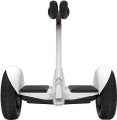Range
The average distance that can be driven on a single battery charge. Usually, the range is indicated with some overestimation — based on a low (optimal from the point of view of energy consumption) speed, uniform movement on a flat surface, etc. Therefore, the actual battery life may be somewhat less. Nevertheless, this parameter is quite suitable for comparing different models with each other.
Thanks to the development of technology, the range in modern self-balancing vehicles can reach
several tens of kilometers.
Max. speed
The maximum speed that the hoverboard is capable of reaching: on a flat surface, with a full battery charge and an average rider weight. The same parameter is also the maximum safe speed allowed when using this model; in theory, it is possible to accelerate even faster (for example, from a mountain), but this is fraught with breakdown, accident and injury, and therefore is not recommended at all.
Most modern models have a maximum speed of up to 20 km/h, and in “high-speed” vehicles this figure can exceed 30 km/h. Note that a fall from a hoverboard, even at a speed of 10 – 15 km/h, is fraught with serious injuries. Therefore, protective gear is highly recommended.
Wheel size
The diameter of the wheels used in the vehicle. Technically,
larger wheels contribute to rolling ability and reduce sensitivity to obstacles and small bumps. However, these possibilities are influenced by many other factors, not least the engine power: with a weak engine, the unit may not have time to cope with the obstacle, which will lead to the rider falling forward. Therefore, large wheels must be combined with a powerful engine.
By itself, information about the diameter of the wheel can be useful when repairing or replacing it.
Clearance
Clearance is the distance from the lowest point of the hull to the ground; in other words, this is the largest size of an obstacle on the road (in height), that the device can pass under itself. High clearance contributes to cross-country ability. However, it requires large-diameter wheels and, accordingly, an increase in motor power, which in turn affects the weight and price of the device. In addition, self-stabilizing transport is designed primarily for urban use, with driving on a flat surface. Therefore, even in most models, the clearance does not exceed 150 mm, and in some devices, it is only 30 mm.
Battery capacity
Battery capacity of the device in milliamp-hours (mAh)
This parameter characterizes the amount of energy that the battery can store. The
higher the number the more energy the battery stores, respectively, the greater the range (see above) and the more time it will take to charge. However, mAh is a popular, but not very reliable unit of power measurement: the actual amount of stored energy depends not only on the “milliamp hours”, but also on the battery voltage (and it can vary greatly in different models). The actual battery life strongly depends on the power consumption of the unit (determined primarily by engine power). This means that only models with similar performance characteristics and the same battery voltage can be compared with each other in this indicator. And when choosing, it’s easier to focus on more practical indicators — first of all, the range.
Battery capacity
The battery capacity of the device in watt-hours (Wh).
In general, capacity shows the amount of energy that a battery can store. The higher the number, the more energy the battery stores, respectively, the greater the range (see above) and the more time it will take to charge. Note that although watt-hours are used to designate power much less frequently than milliamp-hours (see above), this designation is more reliable, because when evaluating capacity, in this case, the battery voltage is also taken into account (as opposed to counting in mAh). This makes it easy to compare batteries of different voltages. At the same time, do not forget that the energy consumption of different models can also be different, and battery life is easier to evaluate by the directly claimed range.
Voltage
Rated voltage of the battery used to power the machine.
Usually, the more powerful the motors used, the higher the voltage: due to this, it is easier to provide the required battery power (see below). At the same time, this power depends not only on voltage. In addition, manufacturers choose batteries for the specific motor model used to provide the desired performance. Given all this, we can say that this parameter does not matter when choosing a transport. Voltage data may be useful only for battery repair/replacement, finding a charger and other similar tasks.
Power
The power of the motor installed in the device. For models with two electric motors, this paragraph usually indicates their total power.
This parameter is one of the most critical for self-balancing transport. On the one hand, powerful motors improve the efficiency of balancing (especially with the large weight of the rider), allow you to reach high speed, effectively overcome bumps in the road and climb hills. On the other hand, they weigh a lot, are expensive and require capacious batteries to ensure a decent range (which further affects the weight and price of the entire unit). Therefore, motor power, usually, directly depends on the price category of a particular model.
In fact, the more powerful the motors, the better, and the question of choice for this parameter depends primarily on the price.
Full charge time
The time required to fully charge the battery from zero to full capacity. This parameter allows you to estimate how long the breaks should be for a full replenishment of the energy supply. Reducing the charging time makes the use of the device more convenient, but it is achieved through special technologies, which, usually, are not cheap.

